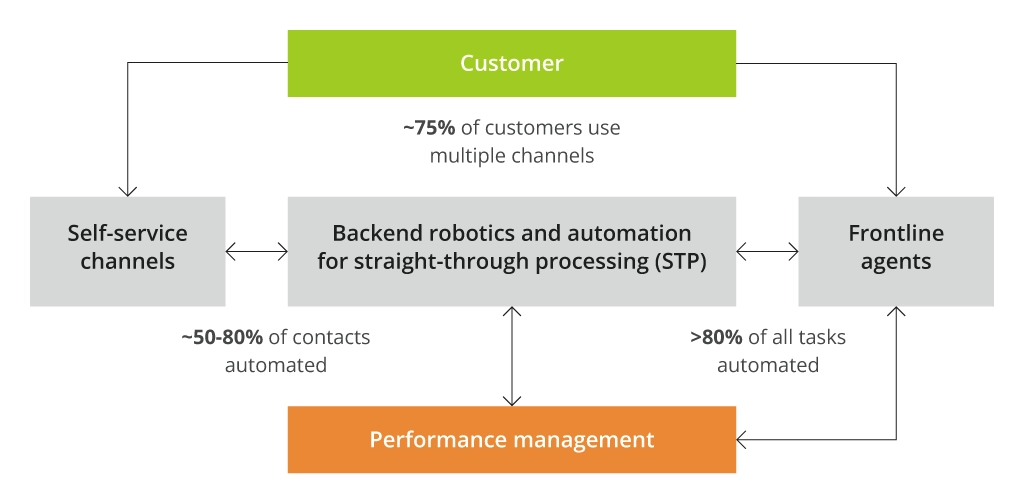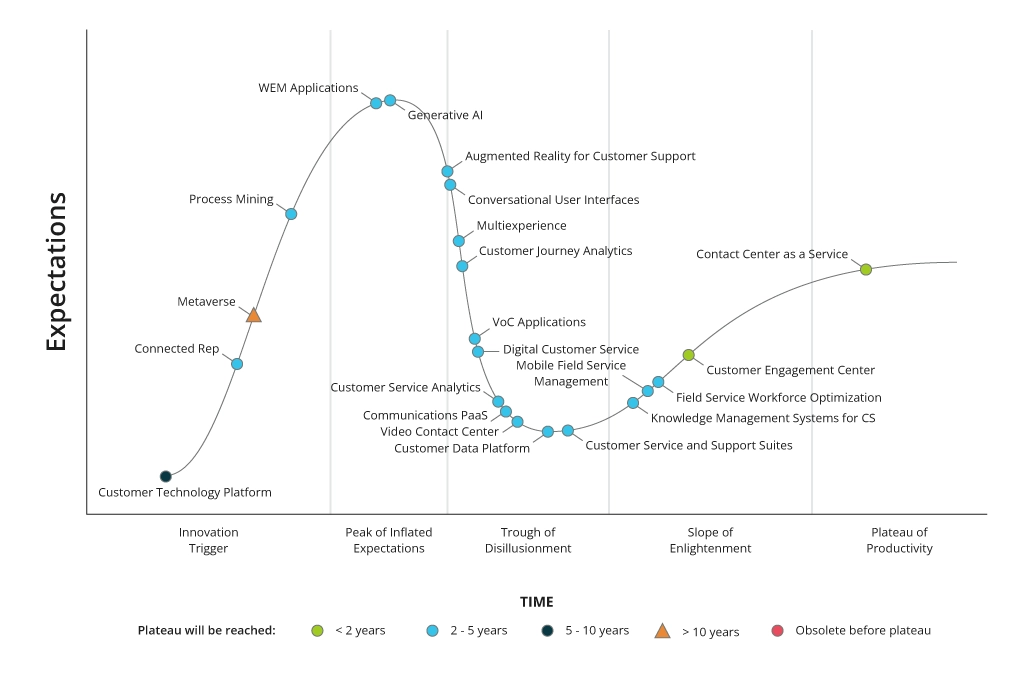Top 5 Ways of Improving Customer Experience in Telecom with Virtual Assistants
In 2024, the telecom industry’s customer satisfaction index has risen to 1-4% compared to 2023, according to the ASCI research. That’s a fine change, but still, there is further work to be done, especially in the wake of rising competition.
Customer Satisfaction Index per Industry
Industry
2023 ACSI
2024 ACSI
% Change
Internet Service Providers
68
71
4%
Non-fiber Internet Service Providers
66
68
3%
Subscription TV Service
69
70
1%
Video Streaming Service
77
79
3%
Wireless Phone Service
74
76
3%
Mobile Network Operators
74
76
3%
Cell Phones
79
81
3%
The Importance of Improving Customer Experience in Telecom
Research and Markets reports that by 2028, the telecom market will reach $3899 billion from $2970.7 billion in 2023, which continues the steady market growth over the recent years. As the market gets more saturated and products in the industry become more commoditized, customer experience has turned into the primary factor that sets companies apart in the highly competitive market.
Deloitte’s 2024 Telecom Industry Outlook states that in the US market, consumers can expect to get more options for broadband connectivity and wireless connection. More options for connectivity means higher competition among providers which should focus on differentiating themselves through superior customer service, reliability, and innovative solutions to meet the demand. Similarly, 5G networks expansion leads telecom companies to adapt their CX strategies to leverage the growing demand for bandwidth-intensive applications. How do the Telecom companies deal with the uprising transformations in CX?
The adoption of AI is transforming customer service models across the industry, shifting towards AI-driven personalized interactions. According to Gartner, by 2025, nearly 80% of customer service and support organizations are projected to use generative AI to improve both customer experience and agent productivity. 38% of leaders even consider enhancing CX and customer retention as the primary objectives behind adopting advanced language models.
If you were wondering how to improve customer experience in telecom, the short answer would be shifting the focus to digital customer servicing. See the practices of adopting AI-powered virtual assistants and their use-cases in Telecom.
Top 5 Ways of Improving CX in Telecom with Virtual Assistants
McKinsey admits that AI-driven CX intelligence can:
- Identify customers who are up to 5 times more likely to churn due to poor network experiences
- Highlight opportunities to reduce capital expenditure by 5-10%
- Increase sales conversions by 10-15%
- Increase customer satisfaction.
At the same time, AI-powered chatbots and virtual assistants help reduce costs in customer service. Now, instead of scaling up the customer service team to ensure 24/7 availability with acceptable response time, you can invest in distant support virtual assistants solution to automate up to 95% of service interactions and requests. Here is how you can apply AI-driven virtual assistants for improving customer experience in Telecom.
1. First-Line Support
Telecom support agents will confirm: most of the first-line technical issues they deal with are standard and repetitive. AI virtual assistants can effectively take over the initial troubleshooting phase. For example:
- Perform tests and run system health-checks
- Run trace/CDRs
- Provide service-specific and general regulatory information
- Provide information about on-going maintenance works and outages
- Log all incidents and requests
- Update and prioritize tickets for human agents.
McKinsey offers the following AI-based customer service build to deliver engaging experience and generate lasting value:
This model involves using AI-powered tools, technologies, and data analytics across all customer touchpoints. The proactivity of the AI-enabled customer service means starting communication with customers before they even reach out with a specific request. Achieving 80% of all tasks automated or higher becomes possible through the following components:
- Proactive communication linked to key demand drivers.
- Intent recognition and nudges before a customer reaches out.
- Omnichannel enablement with self-service for service journeys.
- Conversational AI at each entry point.
- Frontline enablement with coaching for agents supported by the knowledge repository and AI
- Highly personalized, advisory interactions to drive relationship and value, with quick resolution of issues.
- Performance measurement via a centrally managed nerve center that tracks resolution accuracy and efficiency.
Nokia has been successfully using an AI virtual assistant for telecom engineers since 2017. The multi-purpose intelligent knowledge assistant (MIKA) provides quick recommendations to common networking issues and directs users towards relevant knowledge base resources and supporting tools for diagnostics. During the first year of usage, the company reported a significant improvement in the first-contact resolution (FCR) rates for an array of network-related issues.
Vodafone has introduced a new generative AI virtual assistant, SuperTOBi, aimed at addressing more complex customer queries with increased speed and accuracy. SuperTOBi can understand full sentences and complex requests better than traditional chatbots, enabling it to provide faster and more precise responses. It is an upgraded version of Vodafone's previous assistant, TOBi, and is powered by OpenAI models available through Microsoft Azure OpenAI platform. This new tool is set to enhance customer interactions for Vodafone’s European users by offering more efficient and intelligent support.
2. 24/7 Customer Service
In 2020, a lot of companies had to fully switch to remote customer servicing and engagement. Unsurprisingly, this has placed a greater operational toll on support teams, prompting telecoms to re-think how they approach customer support. The tendencies to self-service and automation in customer service remain in post-pandemic era, as it brings cost reductions, better efficiency, and 24/7/365 availability.
Leaders in the industry continue implementing tiered customer service options to rapidly interact with customers at different touchpoints, using a mixture of workforce augmentation solutions powered by automation and artificial intelligence.
- Tier 1. Fully automated self-service: The simplest customer queries can be solved without any human intervention. Salesforce states that 41% of customers prefer self-service to make a purchase, activate services, or make account changes.
- Tier 2. Conversational chatbot support: Chatbots are a staunch addition to on-site self-service portals that provide proactive assistance. For example, help with relevant data look-up, run simple service diagnostics tests, or perform changes in settings, e.g., related to toll-free number accessibility. The same research from Salesforce shows that 41% of customers prefer assisted services, including chat or text to process their requests.
- Tier 3. Human support: Intelligent virtual assistants can reroute more complex issues to human agents, pre-populate tickets for them, and set priority statuses. Additionally, enterprise-grade conversational AI can supply agents with predictive or pre-written answers in real-time and assist with information look-up/compliance. AT&T call centers have an autonomous assistant that instantly analyzes the account of the customer calling. It provides a support agent with a range of relevant options to present to a customer, reducing the response time and personalizing the human support experience.
Arguably, the biggest boon of AI-powered virtual assistants is their self-learning capabilities. As new data becomes available, the efficacy of such solutions grows over time. For instance, Vodafone’s SuperTOBi has increased the first-time resolution rate from 15% to 60%, and net promoter scores showing customer satisfaction with the experience – from 50% to 64%.
3. Accelerated Resolution of Complex Issues
As briefly stated above, virtual assistants can serve as an advanced ‘customer intake form’ of sorts. Through conversation, the chatbot can collect and then transmit the following information to the human agents:
- General customer & account information
- Any technical device specs
- General issue describers
- Resolution approaches attempted
- Severity status
The best-in-class virtual assistants have advanced natural language processing (NLP) capabilities, enabling them to pick out the key terms from unstructured written or spoken conversations and summarize them for the agent. As a result, the customer won’t have to repeat the same things all over again when connected with the agent and the query will be immediately routed to the right department. Telia, a Swedish multinational telecom operator, got 30% of 75,000 monthly customer chats in Finland fully automated. This way, their agents can focus on providing quality, high-level support instead of answering repetitive low-level questions.
4. Personalized and Engaging Services
Telecom networks are intricate systems that are susceptible to technical issues and downtime. Generative AI algorithms can anticipate potential problems before they escalate, ensuring timely maintenance and helping reduce service interruptions.
McKinsey reports that 38% of churn in telecom is driven by network issues – customers seek better voice reception and data speeds. Providers with the highest network quality have 31% higher average revenue per unit (ARPU) and 27% lower churn on average.
By analyzing network data in real-time, AI detects patterns that suggest potential failures so telecom providers can prevent them and minimize interruptions. This results in higher service stability and reliability, thus enhancing customer experience.
With AI-powered chatbots, employees can track the state of networks and be alerted about potential issues. Additionally, they help maintenance teams by providing real-time diagnostics and suggesting solutions.
5. Omnichannel Service Delivery
The boutique is no longer the lone battlefield for telco brands. Social media, websites, affiliates, mobile apps, voice assistants, and IoT devices – all create new touchpoints with customers, forming an omnichannel engagement model.
Gartner admits that customers now expect “instaneous, effortless customer service experiences”. However, adding more channels can potentially increase customer effort as they switch between them.
Telecom companies can address this issue with AI virtual assistants that provide seamless coordination of conversations across multiple channels, ensuring consistent CX across all the touchpoints.
- Social media: Conversational chatbots can be deployed to service existing customers 24/7 and introduce prospects to the full range of services in an engaging manner.
- Voice assistants: Integrated with the company’s websites, apps, and other channels, voice assistants enable users engage with telecom services via voice commands. It simplifies access to account information, plans management, or troubleshooting problems hands-free.
- IoT: Chatbot integrations with ‘smart’ devices — remote controls, TVs — can help create a more interactive product discovery experience for users. In addition, on-device assistants could help with equipment setup, configuration, and technical issue resolution.
To Conclude
AI in telecom has a strong potential to improve customer experience, especially when it comes to first-time resolution rates, average handle time, and average reply time. On top of that, intelligent virtual assistants can also be programmed to engage and retain existing subscribers via hyper-personalized offerings and progressive service discovery. Finally, chatbots can be used to distribute top-of-the-funnel content to facilitate new prospects with digital purchases.
AI in telecom has a strong potential to improve customer experience, especially when it comes to first-time resolution rates, average handle time, and average reply time. On top of that, intelligent virtual assistants can be programmed to prevent network failures and ensure reliable service for customers. Finally, virtual assistants can be used to deliver consistent customer experience across all support channels and minimize customer effort.
Infopulse offers ready-made AI-powered virtual assistants, including customer support chatbot and data analytics bot, and offers technological and advisory assistance to create custom AI-powered solutions.
![CX with Virtual Assistants in Telecom [banner]](https://www.infopulse.com/uploads/media/1920x528-how-to-improve-cx-in-telecom-with-virtual-assistants.webp)




![How to Build Enterprise Software Systems [thumbnail]](/uploads/media/thumbnail-280x222-how-to-build-enterprise-software-systems.webp)
![Super Apps Review [thumbnail]](/uploads/media/thumbnail-280x222-introducing-Super-App-a-Better-Approach-to-All-in-One-Experience.webp)
![IoT Energy Management Solutions [thumbnail]](/uploads/media/thumbnail-280x222-iot-energy-management-benefits-use-сases-and-сhallenges.webp)

![5G Network Holes [Thumbnail]](/uploads/media/280x222-how-to-detect-and-predict-5g-network-coverage-holes.webp)
![How to Reduce Churn in Telecom [thumbnail]](/uploads/media/thumbnail-280x222-how-to-reduce-churn-in-telecom-6-practical-strategies-for-telco-managers.webp)
![White-label Mobile Banking App [Thumbnail]](/uploads/media/thumbnail-280x222-white-label-mobile-banking-application.webp)
![Money20/20 Key Points [thumbnail]](/uploads/media/thumbnail-280x222-humanizing-the-fintech-industry-money-20-20-takeaways.webp)
![Deepfake Detection [Thumbnail]](/uploads/media/thumbnail-280x222-what-is-deepfake-detection-in-banking-and-its-role-in-anti-money-laundering.webp)
![Employee Experience Platforms [thumbnail]](/uploads/media/280x222-top-3-platforms-for-improving-employee-experience.webp)